Mastering the Art of Mixed Drinks at Home
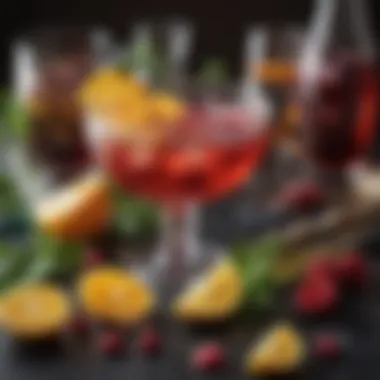
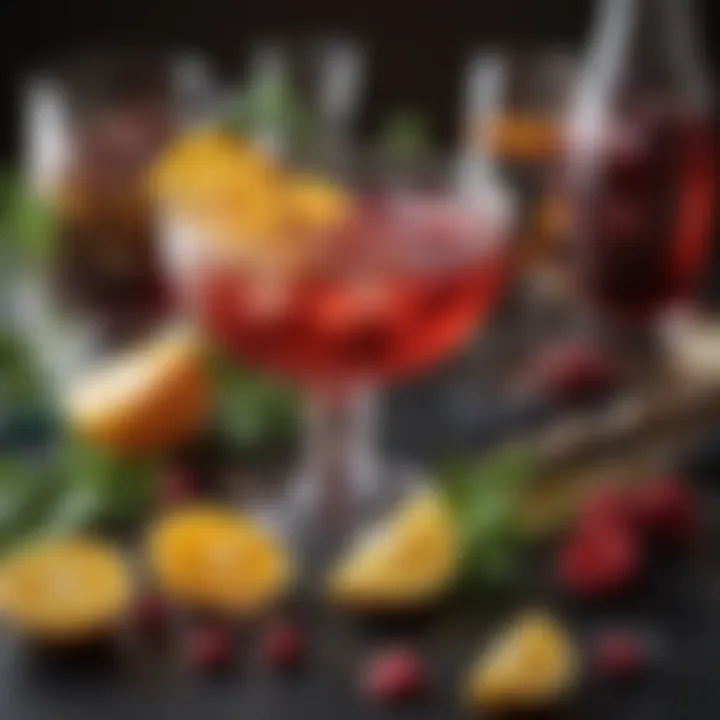
Intro
Crafting mixed drinks at home is more than just a pastime. It represents an opportunity to explore flavors, express creativity, and impress friends and family with well-prepared beverages. This guide aims to demystify the process of making these delightful concoctions, eliminating intimidation often felt by beginners. It offers insights into the essential techniques, ingredients, and tools needed to take your mixology skills to the next level.
Whether you are an aspiring home bartender or someone intrigued by the world of spirits, understanding the fundamentals is key. By grasping flavor profiles, mastering mixing methods, and learning about the right tools, anyone can become proficient in creating equally impressive drinks.
Overall, the following sections will unveil the intricate art of mixed drink preparation, ensuring that readers can savor not just the cocktails themselves but the journey of crafting them.
Intro to Home Mixology
Home mixology has become a popular pursuit for many individuals seeking to elevate their home entertainment experience. The ability to craft mixed drinks not only showcases culinary skill but also enables the host to customize flavors to suit different preferences. Engaging in this craft can also be a rewarding way to impress guests during social gatherings.
Understanding home mixology is essential for several reasons. Firstly, it allows individuals to experiment with various ingredients and develop a personal style. The process of mixing drinks encourages creativity, enabling bartenders to break traditional boundaries and invent unique combinations. Each drink becomes an expression of personal taste and creativity.
Additionally, familiarity with mixology fosters a better appreciation of the art itself. Knowing how different spirits and modifiers interact helps to create balanced and enjoyable cocktails. The knowledge of flavor profiles enhances the overall drinking experience, making it more satisfying.
Moreover, home mixology offers the advantage of cost-effectiveness. Enjoying cocktails at bars can be expensive, whereas making them at home allows for significant savings. Ingredients can be purchased in larger quantities, leading to more experimentation without the fear of overspending.
In terms of social aspects, the act of mixing drinks can become a focal point of social interaction. Engaging friends and family in the mixing process can create a fun and collaborative atmosphere, fostering connections over shared experiences.
Understanding Mixed Drinks
The concept of mixed drinks encompasses a broad range of beverages that combine various ingredients to create unique flavors and experiences. Understanding mixed drinks is crucial for anyone interested in home mixology because it lays the foundation for crafting exceptional cocktails. It enables enthusiasts to combine their creativity with a basic understanding of the components involved.
Mixed drinks are not merely about mixing ingredients; they require knowledge of how flavors interact, the balance between sweet and sour, and the role of texture in enhancing the drinking experience. As one dives deeper into mixology, appreciating the precision in ingredient selection becomes essential.
Moreover, understanding mixed drinks means grasping the cultural significance behind them. Different regions and traditions contribute unique interpretations of a simple idea—blending ingredients. The study of mixed drinks is not just about recipes; it's about understanding a communal field of practices that have evolved over time.
What Constitutes a Mixed Drink
A mixed drink is defined by its combination of at least two ingredients, typically including a base spirit and other flavor-enhancing components. These could be liqueurs, fruit juices, syrups, bitters, or even herbs and spices. The base spirit provides the primary flavor, while the other ingredients complement and enhance it.
Key factors that determine the quality and character of a mixed drink include:
- Base Spirit: The foundation, such as vodka, gin, rum, or tequila.
- Modifiers: Components that alter or enhance the drink’s flavor.
- Balance: The proportion of sweet, sour, and bitter elements needs careful consideration to create a harmonious experience.
- Mixing Method: Depending on the drink's design, strategies such as shaking or stirring will alter the outcome significantly.
A well-constructed mixed drink reflects a balance where no single flavor overshadows the others. Instead, each element works in symmetry, resulting in a drink that is greater than the sum of its parts.
The Evolution of Cocktail Culture
Cocktail culture has evolved significantly from its humble beginnings to become a sophisticated art form appreciated worldwide. The term 'cocktail' first appeared in print in the early 19th century. Initially, it primarily referred to a mixed drink that consisted of spirits, sugar, water, and bitters. Since that time, its interpretation has drastically expanded.
The late 19th and early 20th centuries brought a boom in cocktail culture with the establishment of iconic bars and the publication of influential cocktail manuals. This era introduced countless classics, many of which endure today, such as the Martini and Old Fashioned.
Post-Prohibition in the United States, the cocktail scene faced challenges but eventually thrived again, evolving further into an art form characterized by creativity and innovation. At the forefront of this evolution are modern mixologists, who explore new techniques and ingredients, pushing the boundaries of flavor and presentation.
Today, cocktail culture emphasizes not just the taste, but also the aesthetics and storytelling behind each drink. Consequently, engaging with this rich history is fundamental for anyone aspiring to master the craft of mixed drinks at home.
"Cocktails are a creative expression. They reflect the times we live in and the innovations that inspire us."
By understanding mixed drinks and their evolution, one gains insight into modern practices that bridge tradition with contemporary interpretations. This foundational knowledge is essential for crafting not only classics but innovative variations that resonate with today’s discerning palates.
Essential Tools for Mixing Drinks
In the art of mixology, the tools employed can significantly influence the quality and experience of crafted drinks. The right equipment is not merely a matter of aesthetics; it enhances the efficiency and precision of the mixing process. Each tool has its specific purpose, aiding in the exploration of tastes and textures. Investing in quality tools is a step towards achieving professional results at home.
Key Bar Equipment
Shaker
A shaker is an essential item in any home bar. It allows for thorough mixing of ingredients, ensuring the flavors blend harmoniously. Generally, there are two main types of shakers: the Boston shaker and the cobbler shaker. The Boston shaker consists of two pieces – a metal tin and a glass or another tin, while the cobbler shaker features a built-in strainer and cap.
The main advantage of using a shaker is its ability to impart chill and aeration to the mix. This process enhances the overall tasting experience by creating a refreshing drink. However, beginners may find the Boston shaker a bit challenging due to its two-piece design, requiring a good seal and practice to master.
Strainer
The strainer plays a crucial role in the pouring stage of drink preparation. It separates the liquid from any solid components, such as ice, herbs, or fruit pulp, allowing for a smooth pour into the glass. There are different variations, including the hawthorne strainer, which has a spring coil, and the fine mesh strainer for finer filtration.
The unique feature of a strainer is its effort to maintain the drink’s clarity. Using a strainer prevents unwanted solids from entering the glass, ensuring a visually appealing drink. However, if not used properly, it may slow down the serving process, especially when making multiple cocktails in succession.
Jigger
A jigger is a measuring tool designed to ensure accuracy in pouring spirits and liqueurs. Usually, it features two different measuring sides – typically one ounce and half an ounce. This dual design makes it a favored choice among both professional and home bartenders.
The advantage of a jigger lies in its ability to maintain consistency in drink recipes. Accurate measurements lead to balanced flavors, preventing a cocktail from leaning too sweet or strong. However, it does require some quick calculation for more complex drinks.
Muddler
The muddler is a tool used to crush herbs or fruits to release their flavors into the drink. This technique is particularly prevalent in cocktails such as the Mojito or Old Fashioned, where fresh ingredients enhance the overall experience.
Its key characteristic is the flat or rounded end designed for efficient muddling. A good muddler allows for even pressure distribution without damaging the ingredients excessively. A disadvantage, however, can be its use complexity; a heavy hand may break down ingredients too much, creating bitterness, rather than the intended fresh flavor.
Glassware Types
Highball Glass
The highball glass is essential for serving mixed drinks that require a larger volume of mixer and a long drink. These glasses are typically tall and narrow, designed to hold a good amount of ice while allowing for the drink to be mixed thoroughly.
The highball glass's primary advantage is its simplicity and versatility. You can use it for various cocktails, including gin and tonic or rum and coke. However, its size may make precise layering of drinks difficult.
Cocktail Glass
Often referred to as a martini glass, this glass features a wide, shallow bowl and an elegant stem. It is specially designed to present cocktails that are served straight up, highlighting both the drink and any garnish.
The key aspect of the cocktail glass is its ability to enhance the visual presentation of drinks. However, its fragility can be a drawback; these glasses may not withstand heavy usage in a home setting.


Old Fashioned Glass
The old fashioned glass, also known as a rocks glass, is short with a heavy base, perfect for serving spirits neat or cocktails on the rocks. This glass type is particularly designed for cocktails such as the Old Fashioned or Negroni, where the drink benefits from being served over ice.
Its distinctive characteristic is its robust construction, which adds a sense of substance. While it is highly functional, the downside could be that it limits the mixologist to a more specific type of cocktail, as its volume accommodates fewer mixers.
Selecting Your Ingredients
Choosing the right ingredients is crucial for crafting excellent mixed drinks. Ingredients shape the flavor, aroma, and overall quality of cocktails. Selecting spirits and mixers with care can elevate a simple drink into a memorable experience. Each component contributes unique characteristics, making it essential to understand their roles.
Spirits and Liqueurs
Spirits form the backbone of any mixed drink. Their quality and flavor profile can heavily influence the final product. Each type of spirit has its distinct characteristics.
Vodka
Vodka is renowned for its versatility. It has a neutral flavor that allows it to blend seamlessly with various mixers. A key characteristic of vodka is its clear appearance and clean finish, making it a popular choice for many cocktails. Vodka's unique quality is its ability to carry other flavors without overpowering them. This makes it a beneficial option for creating refreshing drinks. However, its lack of distinct flavor may be seen as a disadvantage by those who prefer spirits with more character.
Gin
Gin offers a complex flavor profile due to its botanical infusions. The primary aspect of gin is its juniper flavor, complemented by various herbs and spices. This complexity makes gin a favorite for classic cocktails such as the Martini. The advantage of gin is its aromatic quality, which can enhance the overall drinking experience. On the downside, its unique characteristics may not appeal to everyone, particularly those seeking a milder taste.
Rum
Rum is often associated with tropical cocktails. Its sweetness can add a rich flavor to mixed drinks. One of the key characteristics of rum is its versatility, ranging from light to dark varieties. Light rum tends to be cleaner and sweeter, while dark rum can provide depth and richness. Rum's unique feature is its ability to convey a sense of warmth and exoticism to cocktails. While its sweetness can be an advantage in some situations, it may also overpower more delicate flavors in cocktails.
Whiskey
Whiskey is known for its bold flavors and diversity. The richness of whiskey comes from its aging process, which imparts deep notes of caramel, vanilla, and smoke. A notable characteristic of whiskey is its complexity, offering a layered taste experience that can stand alone or mix well with other ingredients. It is a popular choice for sophisticated cocktails, such as the Old Fashioned. However, its strong flavor may not suit everyone's palate when trying lighter drinks.
Mixers and Modifiers
Mixers and modifiers are essential for balancing flavors in cocktails. They can deepen, contrast, or brighten the primary spirit's taste.
Sodas
Sodas provide effervescence and sweetness to drinks. A primary characteristic of sodas is their bubbly nature. They can enhance a cocktail's liveliness, making them a popular choice for mixed drinks. The unique feature of sodas lies in their wide variety, from straightforward cola to artisanal tonic waters. However, excessive sweetness can mask other flavors, a common drawback in some cocktails.
Juices
Juices are foundational elements in many cocktails. Freshly squeezed juice can add brightness and acidity. A key characteristic of juices is their natural sweetness and tangy flavor, which can complement or contrast with spirits. The unique aspect of juices is the freshness they bring to drinks. The downside is that juices can spoil quickly and may require careful selection to avoid overly sweet combinations.
Syrups
Syrups add sweetness and depth. They can range from simple sugar syrup to flavored varieties, each contributing distinct notes to a drink. A crucial characteristic of syrups is their ability to integrate sweetness without diluting the drink. Their unique feature is the range of flavors available, which can enhance the complexity of cocktails. However, over-sugaring can lead to unbalanced flavors, a known disadvantage.
Bitters
Bitters are concentrated flavor extracts used in small amounts. The primary aspect of bitters is their complexity, often deriving from various herbs, spices, and fruits. They are crucial for adding depth and nuance to cocktails. Bitters' unique feature is their ability to enhance flavors without overwhelming the drink. However, their potent nature means they must be used sparingly to avoid overpowering the other ingredients.
Fundamental Mixology Techniques
Mastering fundamental mixology techniques is essential for anyone looking to refine their skills in crafting mixed drinks at home. Understanding these foundational methods not only enhances the quality of the cocktails but also elevates the entire mixing experience. These techniques, such as shaking, stirring, and muddling, each serve specific purposes in achieving the desired flavor and texture of a drink. By grasping these techniques, you can better appreciate the nuances of different cocktails and foster creativity in your mixing.
Shaking vs. Stirring
Shaking and stirring are two primary methods that dictate how ingredients blend in your cocktail. Each technique influences the drink’s final taste, texture, and presentation.
Shaking is typically employed for cocktails that contain juices, cream, egg whites, or other components that benefit from vigorous mixing. This technique not only combines the elements but also aerates the mixture, resulting in a more refreshing and lively drink. When using a shaker, include ice to chill the mixture while also diluting it appropriately. This balance between cold and dilution creates a well-rounded cocktail.
Stirring, on the other hand, is used for spirits and drinks that are primarily liquor-based. This gentler method helps maintain the clarity and smooth texture of the ingredients. During stirring, a bar spoon or mixing glass is used to mix ingredients without introducing air. The goal is to achieve a chilled cocktail while retaining the integrity of the flavors.
"Choosing between shaking and stirring often depends on the specific drink recipe and desired outcome."
Common cocktails using each method include:
- Shaking:
- Stirring:
- Daiquiri
- Whiskey Sour
- Pina Colada
- Manhattan
- Negroni
- Martini
By understanding when to shake or stir, you sharpen your mixology skills, allowing for better control over the final product.
Muddling Ingredients
Muddling is a technique that involves pressing or bruising herbs, fruits, or spices to release their flavors. This method is particularly significant in cocktails where fresh ingredients play a crucial role. Muddling allows for the extraction of essential oils and juices, which are essential for achieving a balanced taste.
When muddling, it’s important to use the right tool, typically a muddler, to gently crush the ingredients without shredding them. Over-muddling can lead to bitterness or undesirable flavors that spoil the drink. The goal is to tap into the fresh essence while retaining the character of the ingredient.
Commonly muddled ingredients in cocktails include:
- Mint (for mojitos)
- Fruits like lime (for caipirinhas)
- Berries (for berry spritzers)
The proper technique not only enhances the flavor but also enriches the overall sensory experience of the drink. Learning to muddle effectively adds depth to your cocktails, making them fresh and aromatic.
In summary, mastering these fundamental mixology techniques is vital when aiming to craft exceptional mixed drinks. With practice, the clarity of shaking, stirring, and muddling will enable you to create cocktails of remarkable quality and sophistication.
Flavor Profiles and Pairings
Understanding flavor profiles and pairings is crucial for creating balanced and enjoyable mixed drinks. The taste experience is affected by how different ingredients work together. A well-balanced cocktail can elevate an occasion, whether it is a simple gathering or a formal event. Here we explore how flavor profiles influence the overall drink experience, focusing on balance and harmony among ingredients.
Understanding Flavor Balancing
Flavor balancing involves harmonizing various tastes to create a pleasing drink. The main elements are sweetness, acidity, bitterness, and umami. Each component can enhance or overshadow others, which is why knowing how to balance them is essential.

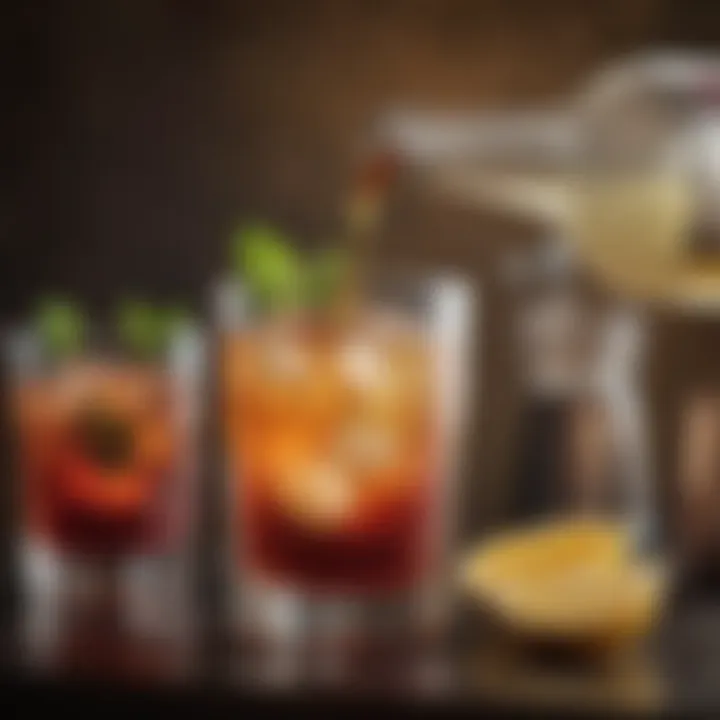
Key points to consider include the following:
- Sweetness: Often derived from liqueurs, syrups, or fruit juices, sweetness can round out harsher flavors.
- Acidity: Citrus juices such as lemon or lime can create brightness in a drink. They help counterbalance sweetness and add complexity.
- Bitterness: Ingredients like bitters or certain herbal liqueurs can add depth. They often serve to elevate the overall flavor experience.
- Umami: While not common in all drinks, umami flavors can provide unexpected richness, often found in savory cocktails.
A well-crafted drink respects these flavors and recognizes their interactions. Experimentation is key, but awareness of how these elements react will lead to more successful combinations.
Creating Unique Flavors
Creating unique flavors is what distinguishes a good mixed drink from a memorable one. Several elements, like herbs, spices, and fruits, can contribute to these unique profiles.
Herbs
Herbs can be a vital element in cocktail crafting. They contribute fresh, aromatic components that can enliven a drink. Basil, mint, or thyme add diverse flavor notes, making a drink refreshing and complex.
- Key Characteristic: Herbs offer freshness and brightness.
- Why Use Them: They elevate base spirits by adding layers of flavor.
- Unique Feature: Muddling herbs releases essential oils that enhance the aroma dramatically.
- Advantages/Disadvantages: While herbs can provide freshness, they can become overpowering if not balanced well. It is crucial to use the right quantities to maintain harmony.
Spices
Spices add warmth and depth to cocktails, making them suitable for various occasions. Cinnamon, cardamom, and pepper can introduce new complexity to drinks. They are especially useful in seasonal cocktails or those designed for flavor exploration.
- Key Characteristic: Spices can deliver heat and flavor depth.
- Why Use Them: They encourage unique mixes that stand out.
- Unique Feature: Spices can often transform a standard cocktail into something exotic and aromatic.
- Advantages/Disadvantages: Like herbs, spices need careful measurement. They can sometimes overwhelm a drink's intended taste if overused.
Fruits
Fruits are fundamental in mixology, providing sweetness, acidity, and juiciness. Options like berries, citrus, and stone fruits bring life to a drink. Their natural sugars often balance bitterness and enhance the overall flavor experience.
- Key Characteristic: Fruits introduce vibrant colors and natural sweetness.
- Why Use Them: They can complement or contrast other ingredients beautifully.
- Unique Feature: Fresh fruits provide textures and visual appeal that can make a drink more inviting.
- Advantages/Disadvantages: Fresh fruits may vary in ripeness and flavor intensity. Ensuring consistent results may require testing over time.
Crafting drinks requires an understanding of how to manipulate flavors. Knowledge of herbs, spices, and fruits can positively influence your mixology skills. This understanding results in better drinks that impress guests and makes the craft of mixing enjoyable.
Classic Mixed Drink Recipes
Classic mixed drink recipes are essential to any home mixology guide. They provide a foundation upon which more advanced cocktail crafting can be built. Understanding these recipes allows bartenders, both novice and experienced, to appreciate the history and culture behind these iconic beverages. Mixing classic recipes fosters a sense of connection to the art of cocktail-making, and relaying the stories behind them makes the experience even richer. Moreover, these drinks feature a balance of flavors that speaks to the principles of mixology.
Iconic Cocktails to Try
Mojito
The Mojito is a refreshing, vibrant cocktail that showcases the versatility of rum. Its bright flavor profile combines mint, lime, sugar, soda water, and white rum. This drink is a beneficial choice due to its ability to bring a cooling sensation, making it ideal for warm weather. The unique feature of the Mojito is its use of fresh mint leaves crushed into the mixture, which releases essential oils that enhance the overall aroma and taste. However, the Mojito can be challenging to maintain, as the freshness of mint can easily wilt over time.
Martini
A Martini represents one of the most classic cocktails, distinguished by its simplicity. Made typically with gin and vermouth, the Martini has a key characteristic in its purity and refinement. It's a beneficial choice for those seeking an elegant and serious drink, often associated with sophistication. The unique feature of a Martini lies in the gin's botanical flavors, which can be tailored by selecting various brands and styles. Yet, a common disadvantage is its potential bitterness if the proportions are not well-balanced, making it critical to practice.
Old Fashioned
The Old Fashioned is a cocktail with a storied past and serves as a benchmark for many drink-making practices. It typically consists of bourbon or rye whiskey, bitters, a sugar cube, and a twist of citrus rind. The essential characteristic is its straightforward approach, allowing the quality of the whiskey to shine through. This drink is beneficial because it emphasizes craftsmanship over complexity. The Old Fashioned's unique feature is the emphasis on garnishing, where the citrus peel not only adorns the glass but infuses the drink with aromatic oils. However, it may not appeal to everyone due to its stronger flavor profile, which can be off-putting for some beginners.
Variations on Classics
Variations on classic cocktails play an important role in home mixology. They allow bartenders to experiment with flavor profiles while still honoring traditional recipes. Making small adjustments in ingredients can result in completely new experiences. Some popular variations include adding fruit purees to a mojito or swapping gin for vodka in a martini. This flexibility makes cocktails more approachable to those who may not prefer the original recipes.
Innovative Mixed Drink Concepts
The realm of mixed drinks is not static. Innovations within this space can transform simple beverages into extraordinary experiences. Innovative mixed drink concepts play a crucial role in appealing to adventurous palates and discerning tastes. They allow bartenders and home mixologists to not only express their creativity but also to engage patrons with unique offerings.
As society evolves, so do preferences towards flavors and ingredients. Consideration of local and seasonal availabilities further enriches this landscape. This section explores two key avenues of innovation: seasonal ingredients and crafting signature drinks.
Seasonal Ingredients
Using seasonal ingredients in mixed drinks is essential for several reasons. First, it enhances freshness. Ingredients that are in season tend to have more flavor compared to those that are out of season. A tomato during summer months, for instance, is more vibrant, sweet, and juicy than those available in winter.
Benefits of Seasonal Ingredients:
- Flavor: Seasonal produce tends to be fresher and offers better taste.
- Sustainability: Choosing what’s in season supports local agriculture and reduces the carbon footprint from transport.
- Variety: Seasonality introduces diversity to your mixology repertoire, helping to avoid monotony.
When crafting mixed drinks, consider the local produce available, such as fresh berries in summer or hearty spices in winter. Infusions can be made with seasonal herbs like basil or mint, offering refreshing accents in the warmer months. In contrast, rich flavors from spices like cinnamon or nutmeg can bring warmth to cold-weather cocktails.
Crafting Signature Drinks
Creating signature drinks provides a personal touch to the art of mixology. Signature drinks showcase a blend of unique flavors that reflect the creator's personality and preferences, thus making them memorable for guests.
Considerations for Crafting Signature Drinks:
- Personalization: Think about flavors you enjoy and how they can be intertwined. This connection helps convey a story to the drink.
- Balance: Set out to achieve a balance between sweet, sour, bitter, and umami elements. A well-rounded drink entices the palate.
- Presentation: The visual aspect matters. Layering, garnishes, and glassware can make a significant impact on the overall appeal.
When designing a signature drink, it can be helpful to start with a base spirit and build flavors from there. Think about how different ingredients come together. For example, a gin-based drink might pair well with elderflower liqueur and fresh lemon juice to create a light and refreshing cocktail optimized for outdoor gatherings.
"Innovation in mixed drinks not only excites the palate but also invigorates the community around home mixology." — Anonymous
Healthier Alternatives in Mixed Drinks
As the interest in a balanced lifestyle increases, the quest for healthier alternatives in mixed drinks becomes paramount. Whist enjoying cocktails is often about taste and indulgence, it is equally important to consider the health implications of what we consume. Many people today are looking to enjoy their cocktails while minimizing calorie intake and enhancement of overall well-being. Choosing lower-calorie mixers and incorporating natural ingredients can offer ways to enjoy mixed drinks without compromising health.
Low-Calorie Mixers
Curbing calories does not mean sacrificing flavor. There are several options for low-calorie mixers that can add depth to your cocktails without unnecessary sugars. Here are some popular choices:
- Club Soda: A classic mixer, this sparkling water adds fizz without calories. It's an excellent base for various spirits and can enhance the drink without altering the flavor profile.
- Tonic Water: While traditional tonic water can be high in sugar, many brands now offer lower-calorie or diet versions. These maintain the same flavorful bitterness, complementing gin beautifully.
- Fresh Juices: Using freshly squeezed juices can keep the drinks lighter. Limiting juices to a minimum allows the natural sugars from fruits without heavy syrups.
- Herbal Infusions: Herbal infusions can replace sugary mixes. Adding homemade herbal tea or infusions can provide unique flavors with fewer calories.
"Consider replacing sugar-laden mixers with more natural or low-calorie options; your body will thank you."
Incorporating these mixers can significantly reduce caloric intake while crafting delightful flavors. The benefits of low-calorie mixers go beyond just calorie reduction; they can also improve hydration and contribute to overall wellness.
Herbal and Natural Ingredients
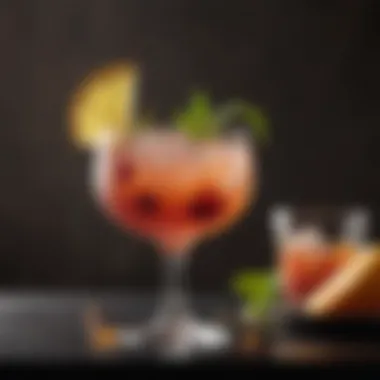
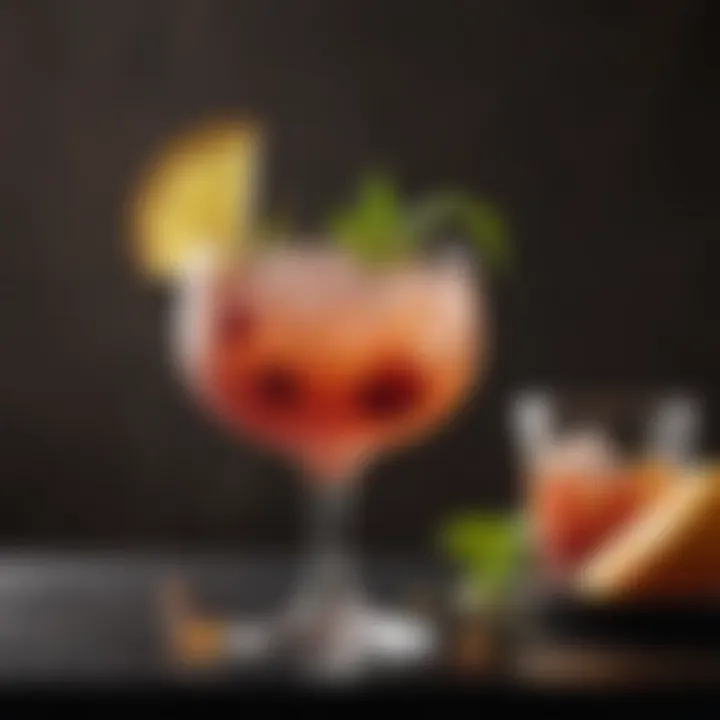
Including herbal and natural ingredients is a compelling way to enhance mixed drinks. These ingredients not only add flavor but also provide various health benefits. The use of herbs and natural components can ultimately create a more balanced drinking experience.
- Mint: Often used in mojitos, fresh mint delivers a refreshing taste. Drinking mint-infused cocktails can also support digestion.
- Basil: Similar to mint, basil can add a unique twist to beverages. This herb is known for its anti-inflammatory properties and complements fruit flavors well.
- Ginger: Known for its health benefits, ginger can spice up cocktails, offering a warmth that pairs well with many spirits.
- Antioxidant-Rich Fruits: Adding berries or citrus slices can provide necessary vitamins and enrich the drink's nutritional profile.
Using these ingredients makes cocktails more vibrant and healthy. They enhance flavor while contributing vital nutrients. Being mindful of what goes into mixed drinks can lead to a satisfying and health-conscious experience for everyone.
Presentation and Garnishing Techniques
In home mixology, presentation and garnishing techniques play a vital role. A well-crafted drink is not only about taste; visual appeal enhances the overall experience. The appearance can make a cocktail more inviting and exciting. Interestingly, the right garnishes not only add aesthetic value but also can influence the drink's flavor and aroma.
Cocktails are often judged by their look as much as by their taste. A drink that looks appealing can naturally attract more interest from guests. The visual element of a cocktail can elevate an ordinary gathering into a more sophisticated event. It turns the act of drinking into an experience, and this can create memorable moments. Home bartenders are encouraged to understand the various facets of presentation and garnishes to improve their skills.
Importance of Visual Appeal
Visual appeal in mixed drinks is paramount. A drink that is visually pleasing entices the drinker and tells a story about the cocktail. It reflects the care taken in its preparation. Colors, textures, and arrangements contribute to this appeal. A bright and vibrant drink can signal freshness and quality ingredients. For these reasons, investing time in the visual aspects of cocktail making is not just about show but also about enhancing the overall enjoyment.
For example, a well-poured cocktail layered with various colors can captivate the eye. Such presentation can cause anticipation before the first sip is taken. Furthermore, using glassware that suits the drink can enhance the visual experience.
Common Garnishes
Garnishes may seem like small additions, but they can significantly impact the drink's character. Common garnishes often include citrus twists, herb sprigs, and edible flowers.
Citrus Twists
Discussing citrus twists, these are popular for good reason. A twist of lemon or lime adds brightness and a burst of citrus aroma to a drink. This enhances the freshness without overpowering the intended flavors. Citrus twists are beneficial because they are easy to prepare and visually appealing. They create a vibrant contrast against darker liquids and bring a hint of zest. However, it's essential not to overdo it; a little goes a long way in achieving balance.
Herb Sprigs
Herb sprigs, such as mint or basil, are another excellent garnish choice. They contribute not only to the aesthetic but also to the aromatic profile of the drink. A sprig of mint, for instance, can signal freshness and health. The light green color often harmonizes well with various cocktails. Plus, when a drinker inhales the scent of the herb before taking a sip, it can enhance the tasting experience. However, care should be taken to avoid overpowering the drink's core flavor with strong herbaceous notes.
Edible Flowers
Edible flowers offer a visually stunning option for garnishing mixed drinks. Varieties like violets or nasturtiums can add elegance and a splash of color. These floral elements can surprise and delight. They also have the potential to complement certain flavor profiles, particularly in fruity cocktails. Their unique appearance makes them a popular choice for presentation.
However, it's crucial to ensure that the chosen flowers are edible and free from pesticides. While they add an attractive touch, they may not provide significant flavor. Thus, they are best used in conjunction with other garnishes that contribute more to taste.
Each of these garnishing techniques offers unique contributions to the overall experience of mixed drinks at home. Learning and mastering these techniques can set a home bartender apart, making every drink served a memorable affair.
Hosting and Serving Mixed Drinks
In the realm of home mixology, hosting and serving drinks extends beyond mere preparation. It becomes a nuanced experience that defines the atmosphere of any gathering. Focused on creating memorable moments, the act of serving mixed drinks requires attention to various elements: presentation, accessibility, and interaction with guests. Understanding these factors can elevate a simple gathering into a captivating occasion, enhancing social engagement through the shared experience of crafted beverages.
Creating a Home Bar Experience
Creating a home bar experience is essential for setting the tone of any social event. The setup should reflect elegance and functionality, encouraging guests to mingle and explore the variety you offer.
Firstly, consider the bar location. A central spot where guests can gather works best. The bar area should be equipped with essential tools and a selection of spirits, mixers, and garnishes visible and within reach. Ensuring a clean and organized space not only filters creativity but also invites guests to partake actively in the process, potentially fostering conversations around personal preferences and drink recommendations.
Incorporate personal touches that resonate with your style or the theme of the event. This could include unique glassware, bespoke cocktail napkins, or thematic decorations. The visual appeal of the setup is significant; it should entice guests as they approach the bar. For an added layer of enjoyment, consider integrating interactive elements such as cocktail making demonstrations, encouraging guests to personalize their drinks by choosing ingredients or garnishes.
Tips for Serving Guests
When serving mixed drinks, several considerations can enhance the overall experience for both the host and the guests. Here are some effective strategies:
- Know Your Guests: Understand their preferences and any restrictions regarding alcohol consumption. Some might prefer lighter drinks or non-alcoholic options. Offering varied selections can help everyone feel included.
- Provide Clear Menus: A drink menu enhances accessibility and excitement. Listing available options, including ingredients, can assist guests in making informed choices, and it reduces the repetitive queries.
- Garnishing Control: Keep garnishes within reach, allowing guests to personalize their drinks with simple additions. This can lead to engaging conversations as they collaboratively create unique cocktails.
- Mind the Flow: Ensure that you are attentive but not overbearing. Maintain a balance between engaging with your guests and allowing them to feel comfortable as they enjoy their drinks.
- Hydration Options: Don’t forget to provide water or non-alcoholic beverages as alternatives. Keeping guests hydrated can contribute to an overall safer and more enjoyable experience.
In crafting mixed drinks at home, hosting transcends mere beverage service. It is about creating an inviting atmosphere where connections flourish over shared tastes and experiences.
Safety and Responsibility in Drinking
Ensuring safety and promoting responsibility in drinking is vital, especially when crafting mixed drinks at home. This section addresses the implications of alcohol consumption and the measures to encourage safe practices. Understanding the effects of alcohol on one’s body can help the home bartender navigate the complex dynamics of mixing drinks. It also aids in creating a responsible atmosphere when enjoying cocktails at home.
Understanding Alcohol Consumption
Alcohol affects individuals differently, influenced by several factors such as body weight, age, gender, and tolerance levels. When consumed, it can impair judgment, affect coordination, and lead to risky behavior. The average guideline is to consume alcohol in moderation, which is generally defined as up to one drink per day for women and up to two drinks per day for men.
To grasp how alcohol works in the body, it is helpful to be aware of the following points:
- Absorption: Alcohol is absorbed quickly in the stomach and small intestine. Foods typically slow down this process but don't stop it.
- Metabolism: The liver breaks down alcohol, but it has a limited capacity. Excessive intake results in higher blood alcohol concentration levels.
- Effects: Slow reactions and impaired judgment can begin at relatively low levels of consumption. It is crucial to recognize personal limits.
Encouraging Responsible Drinking
Promoting responsible drinking habits in social settings and personal spaces should be a priority. Home bartenders can take steps to facilitate a responsible drinking environment.
Here are a few strategies to consider:
- Educate Guests: Share knowledge about alcohol and its effects. Having open discussions can help guests understand their limits.
- Offer Non-Alcoholic Options: For those who choose not to drink, provide engaging alternatives like mocktails. It ensures everyone feels included.
- Set a Limit: When hosting, consider limiting the number of drinks served or implementing a drink menu that encourages moderation.
- Encourage Hydration: Always offer water alongside alcoholic beverages to keep guests hydrated.
- Promote a Safe Return: Make arrangements for transportation, such as rideshare services or designated drivers, ensuring guests get home safely.
"Responsible drinking is not just about avoiding overconsumption; it’s about creating an enjoyable and safe experience for everyone."
In summary, understanding alcohol consumption and fostering responsible drinking practices are essential components of home mixology. They not only enhance the enjoyment of cocktails but also safeguard the well-being of everyone involved.
Final Thoughts on Home Mixology
Home mixology is an ever-evolving craft. It’s not just about pouring alcohol into a glass. It’s about understanding flavors, ingredients, and techniques. This comprehensive guide has explored key aspects that make up this fascinating world. By honing these skills, home bartenders can elevate their drinking experiences.
Importance of Mastering Home Mixology
Engaging with mixology at home provides several benefits. First, it allows for creativity in drink preparation. Individuals can experiment with flavors that suit their preferences. This personalization fosters a better appreciation for the art of cocktail making. Moreover, crafting drinks can be a rewarding social activity. Friends and family often enjoy collaborating and sharing ideas during drink preparation.
Another significant advantage is the control over the ingredients used. Many commercial cocktails contain excessive sugars and additives. By mixing drinks at home, one can choose fresher and healthier options. This can lead to a more enjoyable experience without compromising one’s health preferences.
Considerations for Aspiring Home Bartenders
As one embarks on their mixology journey, it’s crucial to keep a few considerations in mind:
- Quality Ingredients: Invest in quality spirits and mixers. The taste of a cocktail largely depends on the ingredients used.
- Practice and Patience: Skill development takes time. Consistent practice is key to mastering various techniques.
- Stay Informed: Trends in mixology change frequently. Following resources like Wikipedia or Britannica can provide valuable insights into the latest concoctions and techniques.
Ultimately, home mixology is about enjoyment. It provides an avenue for exploring flavors while bringing people together. Whether it’s through a classic Mojito or an innovative signature drink, the skills acquired in this guide are invaluable. They offer the potential to enhance moments, impress guests, and even develop a deeper love for the craft.
"Mixology is not just a skill, it’s an experience worth savoring."
In summary, the journey through home mixology equips enthusiasts with the knowledge and confidence needed to create memorable drinks. By integrating the skills covered in this guide, anyone can cultivate an impressive array of cocktails in their own space.







